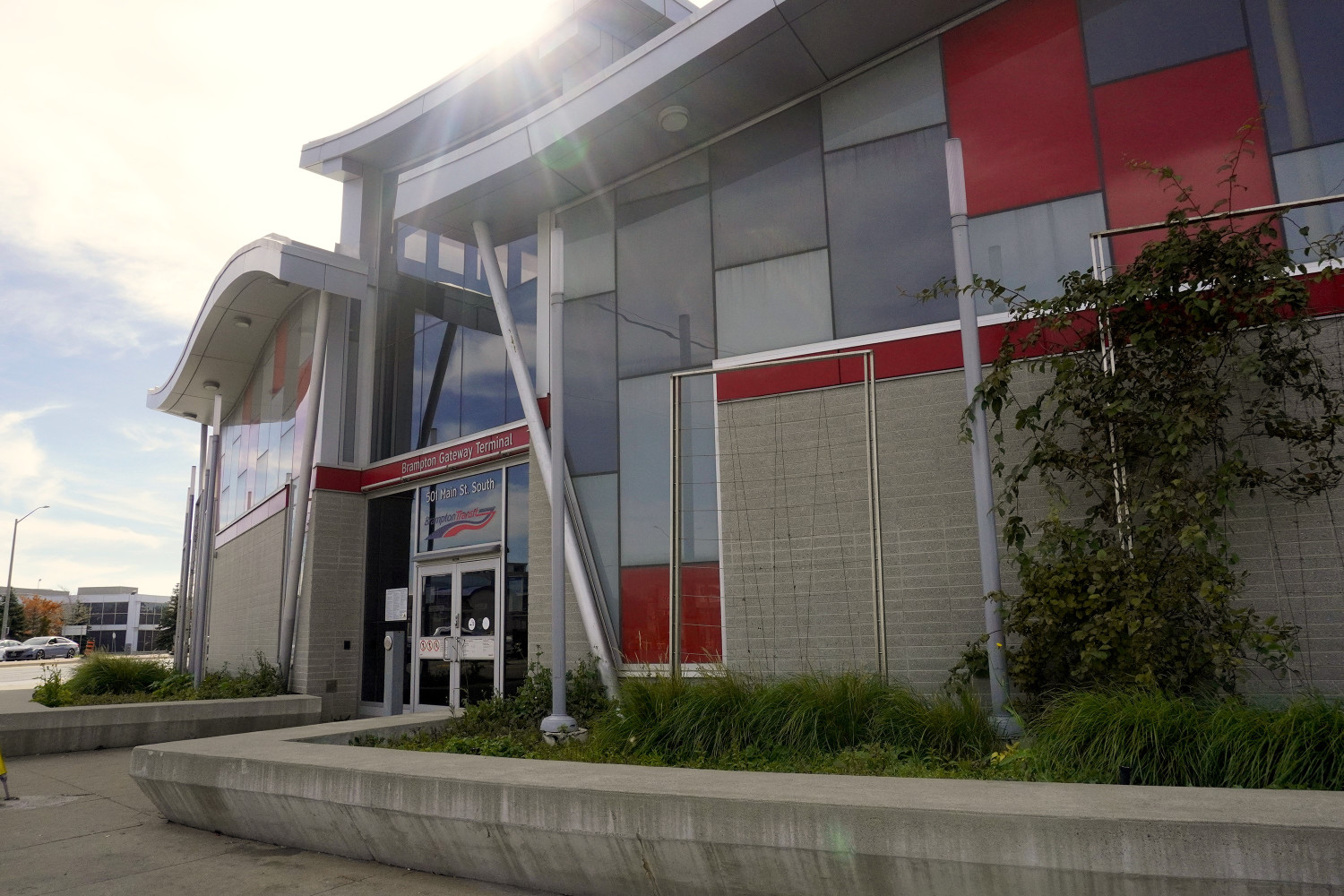
Offices, infrastructure badly needed in Brampton to support growth around major transit areas
A staff report presented to Council two weeks ago highlighted the Region of Peel’s concern over “a servicing capacity issue for most of Brampton’s Primary MTSAs.”
As Brampton tries to move away from its sprawling past, the city’s plan to grow more densely, following an urban not a suburban model, is dependent on transit and other features that need much more investment.
Major Transit Station Areas, or MTSAs, have been designated by the provincial government as key urban nodes in cities where jobs, dense housing, other commercial activity, a range of services and transit should be located. But Brampton, according to the Region and information provided by City staff, has to find significant investments to deliver necessary infrastructure to support its MTSAs, while these areas currently have few jobs for future residents and next to no office space.
“Brampton has a total of 27 MTSAs classified as either ‘Primary’ or ‘Planned’ per the Region of Peel’s Official Plan (ROP),” the report reads. It highlights the goals of MTSA networks which are to facilitate “healthier and more sustainable travel mode choices as an alternative to the private automobile – such as walking, cycling and transit – and enable mobility for people of all ages and abilities.”
The staff report addresses the city’s lack of infrastructure to support white-collar job growth.
“The City of Brampton would require 729,000 sq.m (7,850,000 sq.ft.) of new office gross floor area (GFA) to accommodate office employment to 2051,” the report highlights. “This would represent a 92% increase in the City’s office GFA base over the next 30 years. Over the long term, the City should plan to achieve a target that includes a larger portion of major office employment (MOE) in the office-focused MTSAs, which include Steeles at Mississauga (Rd.), Ray Lawson, Bramalea GO and The Gore. The policies include a combined ratio of MOE and Population Related Employment (PRE) jobs that will need to be achieved within the proposed Office Mixed Use designation for each one of the 4 MTSAs.”
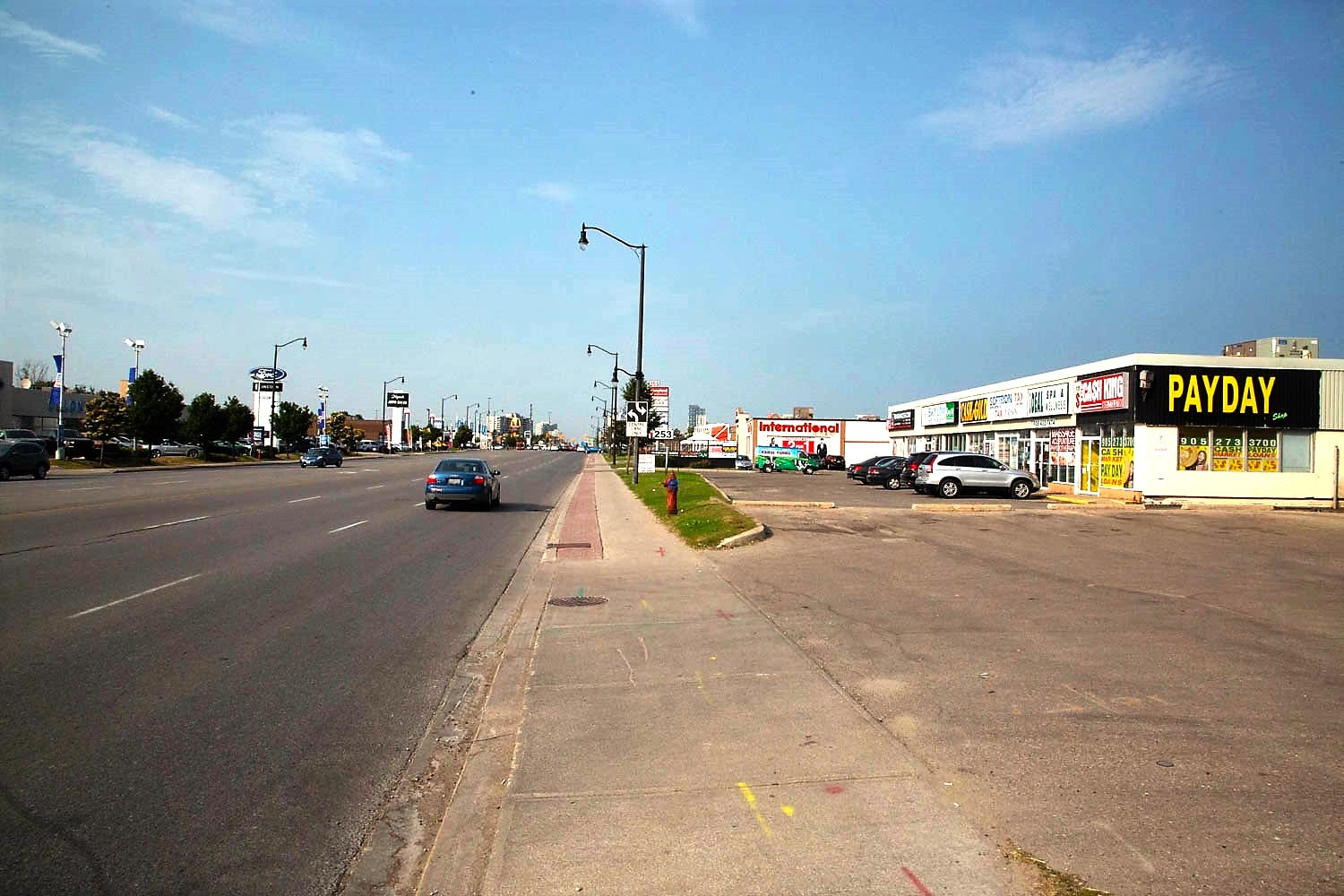
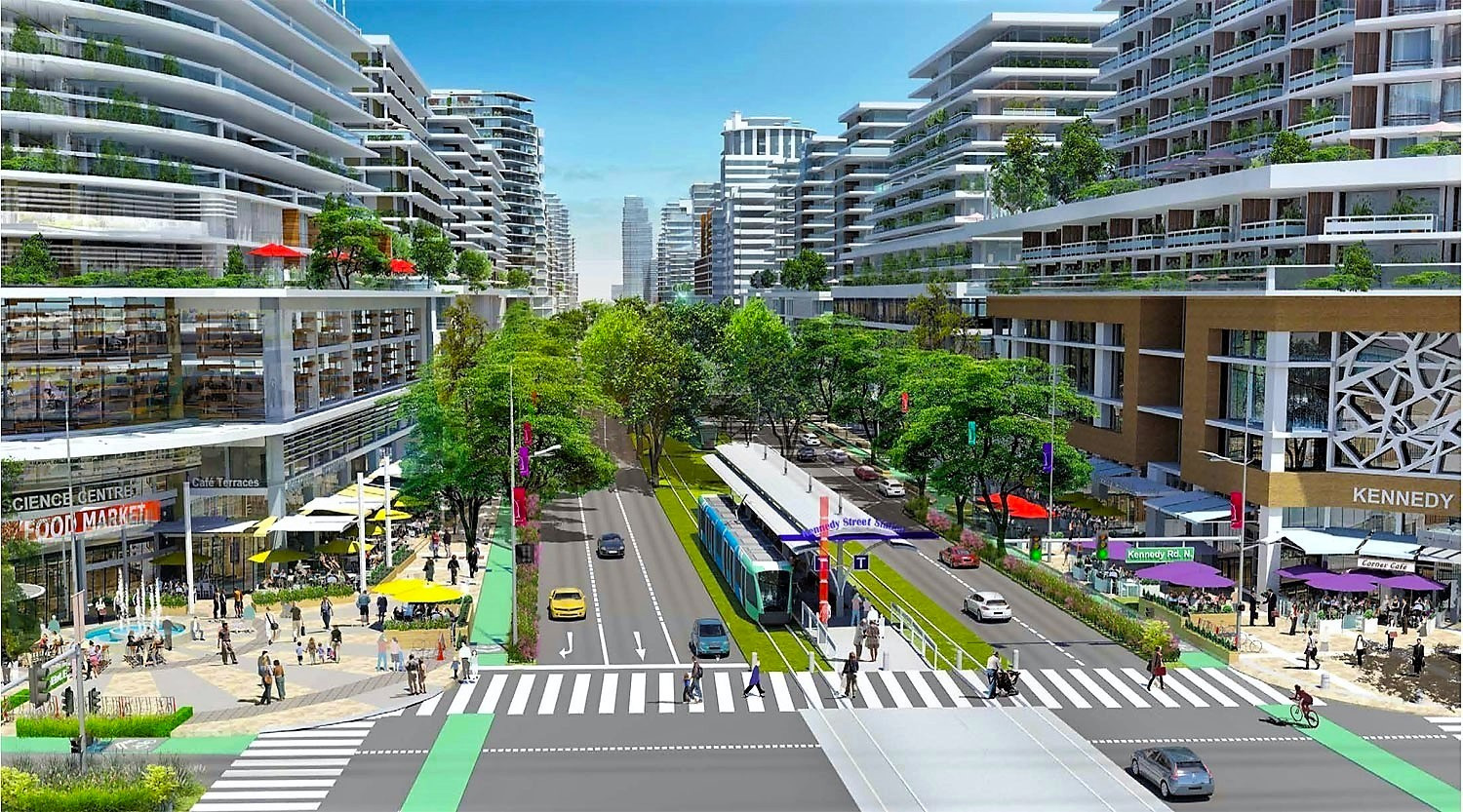
Top: Queen Street in Brampton entering downtown with hardly any office space; Bottom, Queen Street entering downtown with an LRT and plenty of office space so residents don't have to leave for employment, as depicted in the 2040Vision Master Plan.
(The Pointer file photo; City of Brampton)
The PC government has directed Brampton to facilitate the construction of 113,000 new homes by 2031, and doing this in a dense, urban, transit-friendly design, with considerable job growth so residents no longer have to flood out of the city, has been a priority since the 2040 Vision Master Plan was adopted by the City about a half-decade ago.
During the Planning and Development Committee meeting on August 28, Claudia LaRota, Supervisor/Principal Planner, Integrated City Planning, presented the staff report on Brampton’s MTSA land use plans and Draft Brampton Plan policies to Council.
The City defines Major Transit Station Areas (MTSAs) as parts of the city “including and around any existing or planned higher order transit station or stop within a settlement area; or the area including and around a major bus depot in an urban core.” MTSAs are generally within a 500-to-800-metre radius of a transit station, or the equivalent of a 10-minute walk. Primary MTSAs are identified in the Region of Peel Official Plan and in the City’s Master Plan documents. They are set to accommodate the most density, and would ideally house the lion’s share of population growth over the next two decades.
Secondary MTSAs are also identified by the Region of Peel Official Plan but are constrained by existing land use patterns and developments and therefore can require alternative minimum density targets. As the Second Draft Brampton Plan reads, these areas “may take on a commuter station function with a mix of uses that support increased transit ridership.”
Map depicting MTSA Locations and Classifications.
(City of Brampton)
LaRota shared that there are four MTSAs along Steeles Avenue that have been identified as being within the Region of Peel’s designated employment areas and are required to meet specific employment targets and that three of these are subject to a “flexible employment policy framework in the Region’s Official Plan.”
Recognizing the need to protect and foster cultural heritage, an assessment will “identify municipally, provincially, and federally recognized properties within three Study Areas located within the Brampton GO and Centre MTSAs” that have unique value to the city. The City says that as major growth decisions for future planning are made it will be “strongly encouraged that formally recognized heritage assets are maintained to the extent possible to uphold the character and historic quality of the neighbourhood and to support a neighbourhood scale that is accessible and welcoming.”
The Region of Peel describes its Official Plan as being a long-term strategy for managing Peel's growth and development and refers to the provincial Planning Act which requires municipalities to update their official plans every 5 years to ensure they correspond with provincial plans, reflect the province’s priorities and are consistent with the Act’s policy statements.
With the Region of Peel set to dissolve by 2025, its governance over such planning strategies will be left to City Hall, which will have to establish a comprehensive vision that aligns with provincial growth policies and sound urban planning principles.
In April of 2022, Region of Peel Council adopted the new Region of Peel Official Plan, which includes the goal of “ensuring that future growth of population and employment in Peel is anticipated and planned for, and that existing and future finances and services are provided in an effective and efficient manner,” as shared on the Region’s website. Policies within the Region’s Official Plan can only be changed by Regional Council through an amendment. All of these responsibilities will fall to Brampton City Hall by 2025. But the recent reports by the Region and City Staff point out that Brampton’s current infrastructure, such as the municipal water supply, and its capacity to support the types of jobs associated with significant urban growth, are significantly lacking.
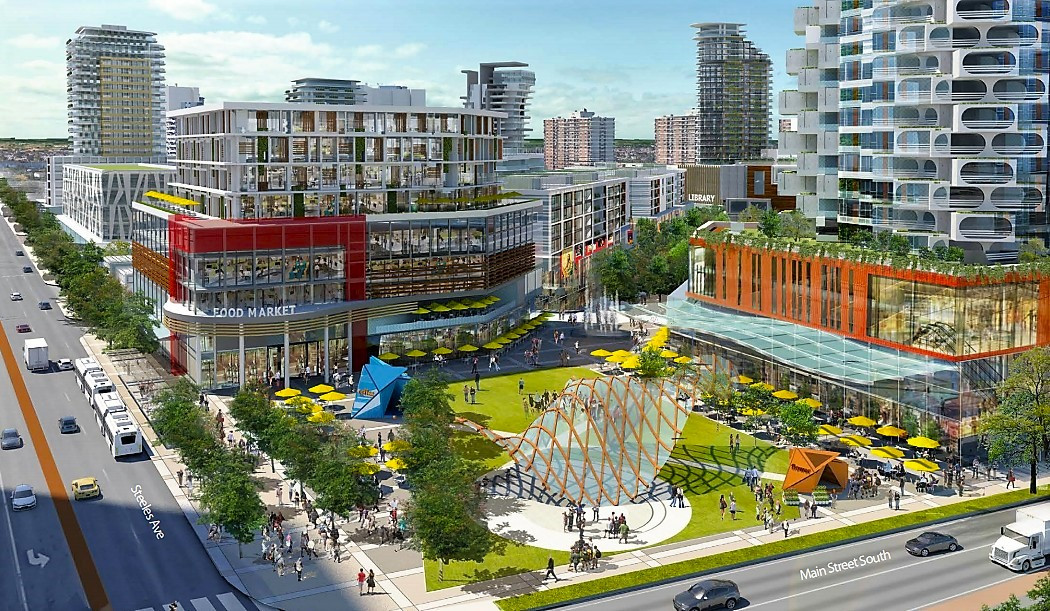
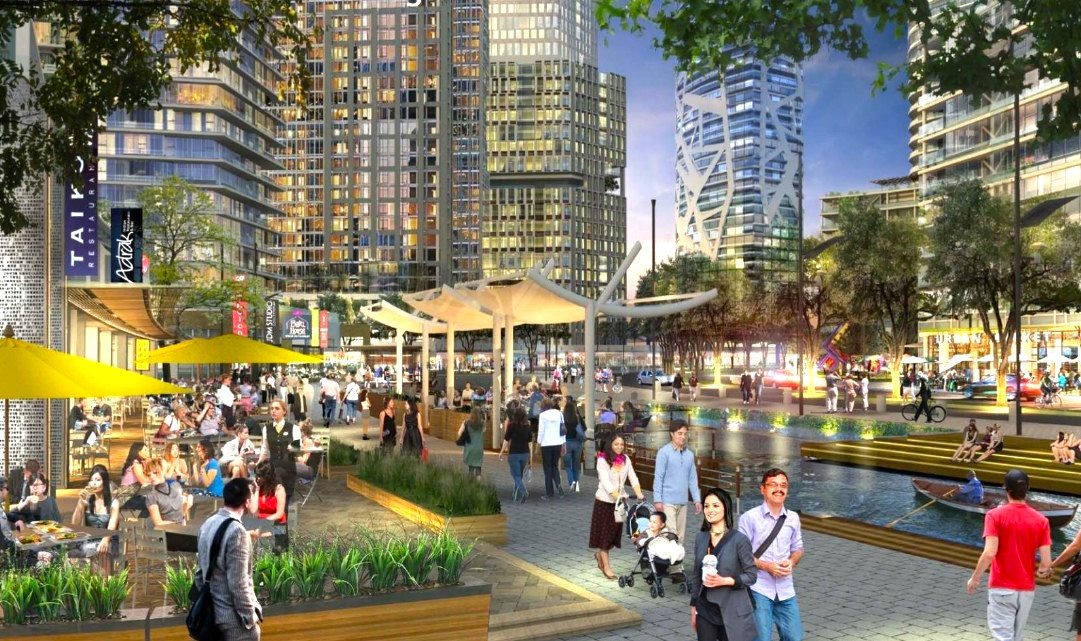
The "2040 Vision" for Brampton includes density and plenty of office space.
(City of Brampton)
The Pointer asked the Region of Peel about the infrastructure servicing capacity issues it identified for Brampton’s Primary MTSAs and which were shared in the City’s August 28 staff report. In an email, Elvis Oliveira, Director, Water/Wastewater IPPC, Public Works, for Peel Region, told The Pointer that, “Peel reviews development pre-consultation and formal development applications as they are submitted. Servicing capacity is evaluated case by case. Peel will continue to work with city staff and developers to find the best short term and long term servicing strategies.”
Oliveira referred to the servicing capacity studies that will be underway. “Once Peel completes the servicing studies, we can determine future service capacity requirements, in collaboration with city staff,” Oliveira said.
One of the biggest looming issues hanging over the PCs’ Bill 23, which paves the way for the construction of 1.5 million new homes across the province by 2031, is how municipalities will pay for the tens of billions of dollars in infrastructure needed to support some three-million residents living in newly built homes, including about 250,000 people in Brampton, in less than eight years.
Oliveira said Peel Region “provides servicing capacity based on growth allocations and timing following our 2020 Master Servicing Plan,” but that the Council endorsed growth scenario within the Plan “no longer reflects what the province and the city is asking for because of recent changes.” These changes, Oliveira highlighted, include the Regional Official Plan 2051 approved by the province in 2022, Bill 23 and municipal housing pledges from March.
“As a result, some Development pre consultations and applications received by the city in 2022 & 2023 are significantly different in density and/or timing compared to the previous approved growth scenario,” he said. “Peel has been collaborating with the city throughout 2023 to identify the priority growth areas and potential growth demands.”
Oliveira, referring to the studies to support the understanding of servicing capacity issues and land use in MTSAs, wrote that, “work is underway to complete studies that will provide the data needed to update the long term servicing strategy and identify short term service capacity opportunities.” He also shared that the Region’s study of the primary MTSAs are expected to be completed by the end of this year.
The staff report shared with Brampton Council says that “at the time of writing this report, the City has received a total of 93 development applications in the ‘Primary’ MTSAs – each at different stages of review and approval.” The report shares that because of the “uncertainty of some of the development applications moving forward to actual construction, the proposed MTSA land use schedules… currently reflect those development proposals that have received Council approval and building permits.”
“As Council has not made a decision on development applications that are ‘in-review’, the proposed MTSA land use schedules may not necessarily align with privately initiated amendments,” the report states. “Pending the outcome of the development application review process and Council’s decision on privately initiated amendments, the land use schedule can be amended to reflect future changes.”
Councillor Harkirat Singh said the Major Transit Station Areas where much of Brampton’s coming growth will be accommodated can expect “a lot of small families,” who he said will need more space than the one-bedroom units developers have pushed in other municipalities.
Highlighting the province’s push to build more homes rapidly, Councillor Singh also said there is a need to consider sustainability metrics. “We need to do it in a sustainable way, so making sure we're looking at net-zero developments… because when we talk about the future this is going to become more and more important.”
The report highlights that the proposed MTSA policies and schedules are intended to be incorporated into the new Official Brampton Plan, which will be forwarded to Council for adoption on November 1.
Email: [email protected]
At a time when vital public information is needed by everyone, The Pointer has taken down our paywall on all stories to ensure every resident of Brampton and Mississauga has access to the facts. For those who are able, we encourage you to consider a subscription. This will help us report on important public interest issues the community needs to know about now more than ever. You can register for a 30-day free trial HERE. Thereafter, The Pointer will charge $10 a month and you can cancel any time right on the website. Thank you
Submit a correction about this story


